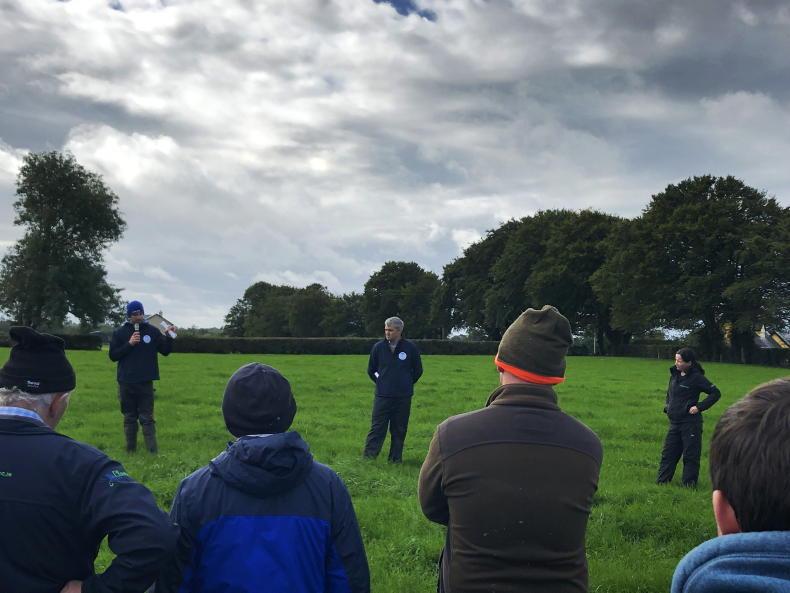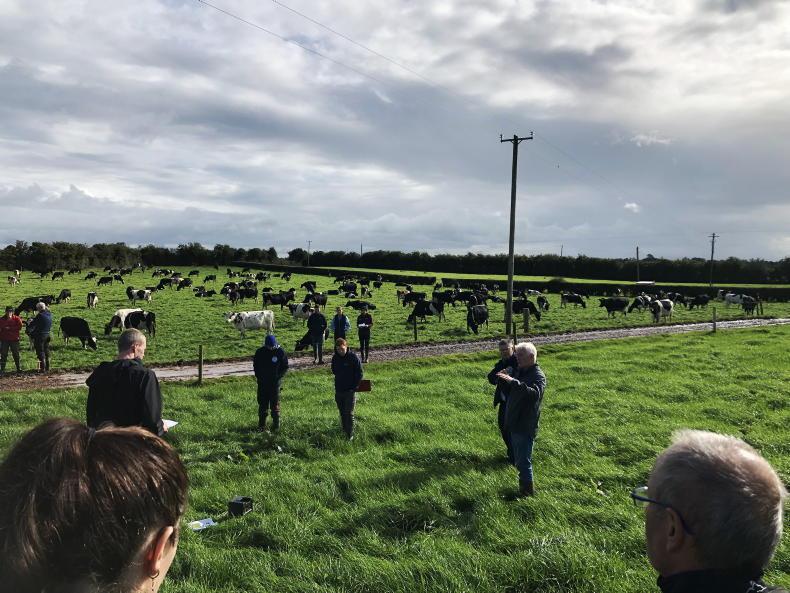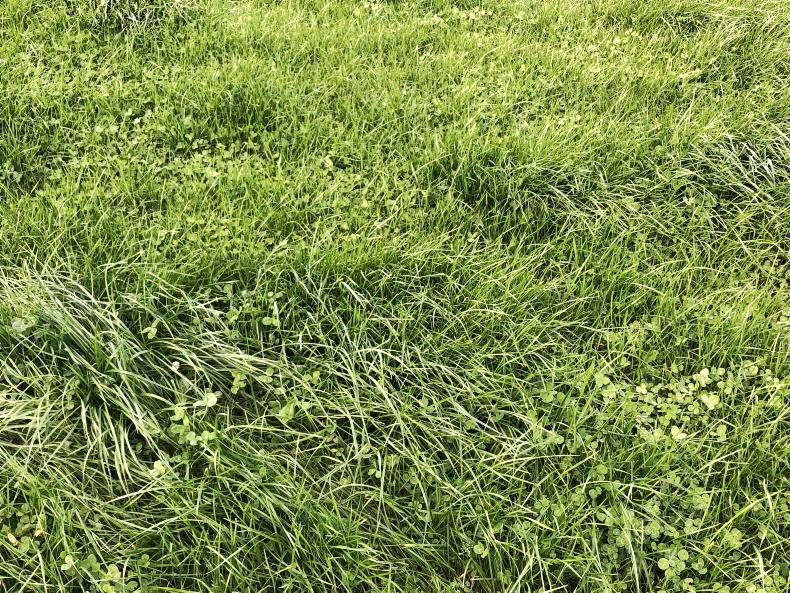Gerry and Niall Moloney are a father-and-son partnership milking 171 cows on a 58ha milking platform in Crecora, Co Limerick. In 2020, they became one of 100 farms involved in the Signpost Programme’s Farmers for Climate Action initiative.
A recent open day on the farm run by Kerry Agribusiness and Teagasc gave farmers an opportunity to learn more about some changes the Moloneys have implemented.
One key focus was how farmers can improve their sustainability and reduce their carbon footprint. The carbon intensity has reduced by 14% to 0.95kg CO2 e/kg milk from 1.08kg CO2 e/kg milk between the last two Bord Bia audits.
Gerry Moloney was quick to point out that they are by no means experts and are continuing to learn as they go. He did, however, acknowledge the need for change and progress as different technologies become available.
“We have seen the reduction that clover, low-emissions slurry spreading and protected urea can have on our impact on the environment.”

Niall Moloney, Mary McEvoy (Germinal seeds) and Robert Prendiville (Teagasc) discussing clover establishment at the Moloneys' Signpost farm walk.
Breeding
One key aspect of sustainability covered on the day is breeding and cow production. Gerry did an AI course in 1994 and has been using top bulls available since. All replacement heifers are AI-bred and the herd EBI is now €161.
With a particular focus on fertility and milk production traits, the Moloneys’ main goal is to breed a cow that will last in the herd and produce over 500kg of milk solids on a predominantly grass-based system. In 2020 they sold 483kg MS/cow and fed 820kg of meal.
The average number of lactations per cow in the herd in 2021 is 4.4. The target for the Signpost farms is an average of four lactations. The low empty rates allow the Moloneys to cull selectively for high SCC, poor production or lameness and this, in turn, improves herd performance.
Over the last six years, the empty rates have ranged from 6% to 14% empty. Gerry put this down to the huge effort they put into the breeding season. Cows are tail-painted twice a week every week and that is the main heat detection aid used.
In 2021, after a 12-week breeding season, 10% of the herd were empty. Of these empty cows, 4% were marked for culling and not bred on purpose. Cows are artificially inseminated for six to seven weeks and beef stock bulls are then left off to clean up. The Moloneys target a replacement rate of 18% and rear around 30 replacements every year.

Gerry and Niall Moloney discussing breeding and herd performance at the Moloneys' Signpost farm walk.
Grassland
management
Niall Moloney started measuring grass when he returned home to farm full-time in 2012 and initially he recorded all grass walks on Microsoft Excel.
In 2016, he joined PastureBase Ireland (PBI) and, in 2018, he won the young grassland farmer of the year competition.
Niall is a big advocate for the PBI app for having all the information and a plan as you leave the last paddocks on the farm walk.
Since 2016, Niall has been recording his grass walks regularly and, in 2020, the farm grew a total of 13.7tDM/ha. With 37 grass covers recorded so far in 2021, the farm had grown 10.7tDM/ha up to 20 September.
The Moloneys are stocked at 3.2 cows/ha on the milking platform and 2.26 cows/ha on the whole farm.
He records all fertiliser applications on PBI, so he has accurate data at the end of the year to compare paddock performance.“If we want to know where we are going, we need to know where we are starting.”
Over the last number of years, the Moloneys have started to incorporate clover into the sward. Stocked at 3.2 cows/ha, Niall knows if fertiliser is restricted he has two options to hold his stocking rate – get clover to fix N or feed more concentrate per cow per year, which he does not want to do.
In 2020, he spread 246kg N/ha and in 2021 he spread 232kg N/ha on the milking platform.
Mary McEvoy from Germinal was at the walk. She said that a reseed gives the best chance of getting clover up to the 20% to 25% level in the sward that is required to see an improvement in animal performance and to allow a reduction in chemical nitrogen. To get a higher percentage of the farm established with clover each year, some level of oversowing will be necessary.
Soil fertility is a key factor to the success of getting clover established, with a target of index 3 for P and K and a pH of 6.3 to 6.5.
Mary said to target getting the clover seed in late April or early May as any later than this, the conditions can become too dry for establishment.
With little or no difference between stitching in clover and using the fertiliser spreader, the most important thing is the management afterwards. Clover requires light to get to the base of the sward so grazing at a cover of 1,100kg to 1,200kg DM/ha for four grazings is essential.
Niall oversowed one paddock in 2021 using the fertiliser spreader. He did not mix the seed with any fertiliser and when spreading he went up and down the length of the field followed by over and back the width of the field.
He picked a paddock with a PH of 6.3 and index four for P and K. The paddock had been reseeded in 2019 with 75% Abergain and 25% Aberchoice so it is an open sward. He chose this paddock as it is near the parlour, so he could monitor it and graze it at a cover of 1,200kg DM/ha.
Niall said that when managing the clover in both the reseed and the oversown paddocks, the rotation had to be altered. Clover paddocks were on a shorter rotation in order to stop covers getting too heavy.
Nitrogen applications were reduced from one unit of N per day to 0.75 units of N per day.

This paddock was oversown with clover in 2021 and grazed at 1,200kg DM/ha for the year. Nitrogen was restricted to .75 units per day.
Reduce greenhouse gas emissions
There are a range of actions that can reduce greenhouse gas (GHG) emissions, including:
An €10 improvement in herd EBI will result in a GHG reduction of 1%.Changing 50% of chemical N from CAN to protected urea can reduce GHG emissions by 4%. A reduction of 50kg to 60kg of concentrates per cow can reduce GHG emissions by 1%. Using 100% low-emission slurry spreading (LESS) equipment can reduce GHG emissions by 2%.In short
Gerry and Niall Moloney are milking 171 predominantly Holstein Friesian cows in Crecora, Co Limerick. They are one of 100 farms involved in the Signpost Programme. The herd EBI is €161.In 2021, they started incorporating clover into the sward through reseeding and oversowing with the fertiliser spreader.Through the use of LESS, protected urea, clover incorporation and increasing the EBI, they have reduced their carbon footprint by 14% over the last two years.
Gerry and Niall Moloney are a father-and-son partnership milking 171 cows on a 58ha milking platform in Crecora, Co Limerick. In 2020, they became one of 100 farms involved in the Signpost Programme’s Farmers for Climate Action initiative.
A recent open day on the farm run by Kerry Agribusiness and Teagasc gave farmers an opportunity to learn more about some changes the Moloneys have implemented.
One key focus was how farmers can improve their sustainability and reduce their carbon footprint. The carbon intensity has reduced by 14% to 0.95kg CO2 e/kg milk from 1.08kg CO2 e/kg milk between the last two Bord Bia audits.
Gerry Moloney was quick to point out that they are by no means experts and are continuing to learn as they go. He did, however, acknowledge the need for change and progress as different technologies become available.
“We have seen the reduction that clover, low-emissions slurry spreading and protected urea can have on our impact on the environment.”

Niall Moloney, Mary McEvoy (Germinal seeds) and Robert Prendiville (Teagasc) discussing clover establishment at the Moloneys' Signpost farm walk.
Breeding
One key aspect of sustainability covered on the day is breeding and cow production. Gerry did an AI course in 1994 and has been using top bulls available since. All replacement heifers are AI-bred and the herd EBI is now €161.
With a particular focus on fertility and milk production traits, the Moloneys’ main goal is to breed a cow that will last in the herd and produce over 500kg of milk solids on a predominantly grass-based system. In 2020 they sold 483kg MS/cow and fed 820kg of meal.
The average number of lactations per cow in the herd in 2021 is 4.4. The target for the Signpost farms is an average of four lactations. The low empty rates allow the Moloneys to cull selectively for high SCC, poor production or lameness and this, in turn, improves herd performance.
Over the last six years, the empty rates have ranged from 6% to 14% empty. Gerry put this down to the huge effort they put into the breeding season. Cows are tail-painted twice a week every week and that is the main heat detection aid used.
In 2021, after a 12-week breeding season, 10% of the herd were empty. Of these empty cows, 4% were marked for culling and not bred on purpose. Cows are artificially inseminated for six to seven weeks and beef stock bulls are then left off to clean up. The Moloneys target a replacement rate of 18% and rear around 30 replacements every year.

Gerry and Niall Moloney discussing breeding and herd performance at the Moloneys' Signpost farm walk.
Grassland
management
Niall Moloney started measuring grass when he returned home to farm full-time in 2012 and initially he recorded all grass walks on Microsoft Excel.
In 2016, he joined PastureBase Ireland (PBI) and, in 2018, he won the young grassland farmer of the year competition.
Niall is a big advocate for the PBI app for having all the information and a plan as you leave the last paddocks on the farm walk.
Since 2016, Niall has been recording his grass walks regularly and, in 2020, the farm grew a total of 13.7tDM/ha. With 37 grass covers recorded so far in 2021, the farm had grown 10.7tDM/ha up to 20 September.
The Moloneys are stocked at 3.2 cows/ha on the milking platform and 2.26 cows/ha on the whole farm.
He records all fertiliser applications on PBI, so he has accurate data at the end of the year to compare paddock performance.“If we want to know where we are going, we need to know where we are starting.”
Over the last number of years, the Moloneys have started to incorporate clover into the sward. Stocked at 3.2 cows/ha, Niall knows if fertiliser is restricted he has two options to hold his stocking rate – get clover to fix N or feed more concentrate per cow per year, which he does not want to do.
In 2020, he spread 246kg N/ha and in 2021 he spread 232kg N/ha on the milking platform.
Mary McEvoy from Germinal was at the walk. She said that a reseed gives the best chance of getting clover up to the 20% to 25% level in the sward that is required to see an improvement in animal performance and to allow a reduction in chemical nitrogen. To get a higher percentage of the farm established with clover each year, some level of oversowing will be necessary.
Soil fertility is a key factor to the success of getting clover established, with a target of index 3 for P and K and a pH of 6.3 to 6.5.
Mary said to target getting the clover seed in late April or early May as any later than this, the conditions can become too dry for establishment.
With little or no difference between stitching in clover and using the fertiliser spreader, the most important thing is the management afterwards. Clover requires light to get to the base of the sward so grazing at a cover of 1,100kg to 1,200kg DM/ha for four grazings is essential.
Niall oversowed one paddock in 2021 using the fertiliser spreader. He did not mix the seed with any fertiliser and when spreading he went up and down the length of the field followed by over and back the width of the field.
He picked a paddock with a PH of 6.3 and index four for P and K. The paddock had been reseeded in 2019 with 75% Abergain and 25% Aberchoice so it is an open sward. He chose this paddock as it is near the parlour, so he could monitor it and graze it at a cover of 1,200kg DM/ha.
Niall said that when managing the clover in both the reseed and the oversown paddocks, the rotation had to be altered. Clover paddocks were on a shorter rotation in order to stop covers getting too heavy.
Nitrogen applications were reduced from one unit of N per day to 0.75 units of N per day.

This paddock was oversown with clover in 2021 and grazed at 1,200kg DM/ha for the year. Nitrogen was restricted to .75 units per day.
Reduce greenhouse gas emissions
There are a range of actions that can reduce greenhouse gas (GHG) emissions, including:
An €10 improvement in herd EBI will result in a GHG reduction of 1%.Changing 50% of chemical N from CAN to protected urea can reduce GHG emissions by 4%. A reduction of 50kg to 60kg of concentrates per cow can reduce GHG emissions by 1%. Using 100% low-emission slurry spreading (LESS) equipment can reduce GHG emissions by 2%.In short
Gerry and Niall Moloney are milking 171 predominantly Holstein Friesian cows in Crecora, Co Limerick. They are one of 100 farms involved in the Signpost Programme. The herd EBI is €161.In 2021, they started incorporating clover into the sward through reseeding and oversowing with the fertiliser spreader.Through the use of LESS, protected urea, clover incorporation and increasing the EBI, they have reduced their carbon footprint by 14% over the last two years. 








 This is a subscriber-only article
This is a subscriber-only article











SHARING OPTIONS: